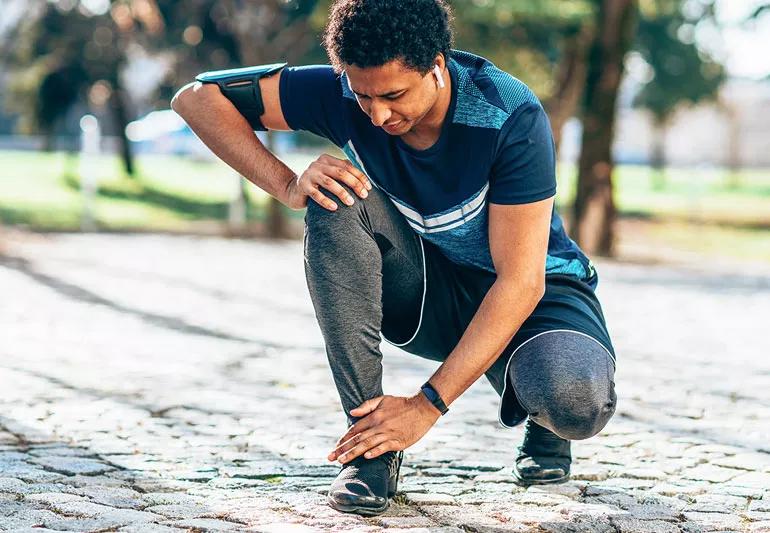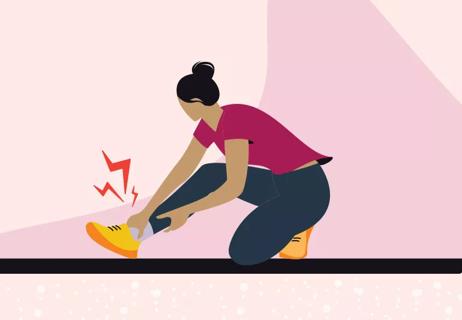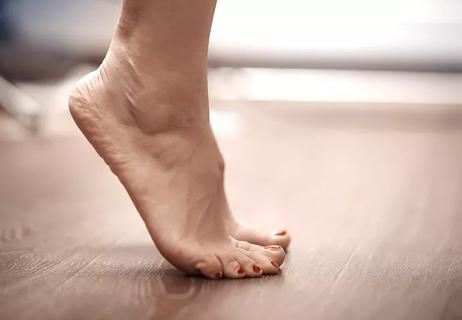An expert discusses shoes, braces and other ways to support your ankles

Who doesn’t dread that ankle injury or sprain that sidelines you for weeks — especially when you thrive on being active?
Advertisement
Cleveland Clinic is a non-profit academic medical center. Advertising on our site helps support our mission. We do not endorse non-Cleveland Clinic products or services. Policy
Any kind of ankle sprain or injury isn’t just painful when it happens. It’s the type of annoying, nagging injury that can linger for weeks. The stiff, painful muscles can make just walking around hard enough, never mind the time you’ll miss running or exercising.
It’s not surprising that people who run or work out regularly will try to prevent these painful injuries in any way possible. While there’s no equipment that can completely prevent ankle injuries from happening, that doesn’t mean safe support is impossible. With the right kind of shoe, brace and exercise, you can give your ankles the support they need without negatively impacting your performance.
To find out what gets you the best ankle support and if high-top athletic shoes are better than low-cut options, we talked to orthopedic surgeon Sara Lyn Miniaci-Coxhead, MD.
On its surface, the idea that high-top athletic shoes offer more ankle support seems like the right one. Dr. Miniaci-Coxhead says the snug protection of high-top athletic shoes can certainly make your ankles feel more stable, but the real question is whether that extra support prevents ankle sprains.
And that’s a question that is still very debatable, she says.
Advertisement
“There are a few studies that suggest the foot inverts less (which is the main mechanism of an ankle sprain) when wearing high-top shoes,” she says. “However, there are also studies saying that, in a dynamic situation, high-top shoes did not prevent excessive inversion.”
So does the type of activity you’re doing matter?
“I think people participating in sports that tend to have a higher risk for ankle sprains (basketball, for example) may benefit from a high-top shoe,” Dr. Miniaci-Coxhead says. She adds that they also may help those who are recovering from an ankle injury or who are more prone to injuries.
However, high-top shoes aren’t the only way to get extra support. “Studies show that high-top shoes, ankle braces and taping are likely all equal in their effectiveness in supporting the ankle,” she says.
As with shoes, there’s no perfect brace that can guarantee you won’t suffer a sprained ankle at one point or another. But braces are still a great way to give your ankles stronger support to better prevent ankle sprains, especially during intense physical activity.
Ankle braces have come a long way over the years and many now offer support without sacrificing too much comfort or flexibility. But there is also an almost overwhelming number of choices and variations.
To make sure you pick the best brace for you, consult your healthcare provider or physical therapist can also help you in the process. It may take a lot of sampling to get the right brace for you but that’s essential to make sure you get the most support you can – and not risk additional injury.
While ankle splints are used to stabilize the ankle, they’re meant for use with injuries or other medical conditions affecting the ankle. They’re not meant for athletic use of any kind. If you think you need to use an ankle splint, please consult your health care provider or physical therapist.
While it may seem that high-tops help, Dr. Miniaci-Coxhead says that the best way to prevent an ankle sprain is less about what you put on your ankle and more about how strong your ankles are.
In fact, she says, research shows that the muscles that evert your ankle (therefore helping prevent sprains) may activate more slowly in high-top versus low-top shoes.
“Another study demonstrated that even though all those devices (shoes, braces, etc.) are helpful in supporting the ankle, the most important thing in preventing an inversion moment is the activation of the muscles that evert the foot,” she says.
So, yes, high-tops and braces can help support your ankles, but, “the best prevention for an inversion injury is having strong muscles on the outside of the foot (evertors), and wearing high-top shoes can cause these muscles to activate later and be less effective,” Dr. Miniaci-Coxhead says.
Advertisement
In the end, she says, wearing high-tops or a brace could help support your ankles, but muscle strength is likely more important than any shoe, brace or taping in preventing injuries.
If you’ve already injured your ankle, it’s important to maintain recovery exercises as pain allows. Treatment of the injured ankle can help prevent further, repeated injuries that can lead to joint issues.
While each person’s body and its recovery are different, Dr. Miniaci-Coxhead says you should be able to start carefully doing recovery stretches and exercises within a few days of the injury. But be mindful of your body. Stop doing the exercises if you experience pain and always check with your healthcare provider.
Range of motion exercises can help loosen the muscles and ligaments around your ankle without putting too much strain on them. One example is ankle circles. In a seated position, lift your leg with the injured ankle off the ground and make slow circles with the foot in one direction for 10 repetitions. When you’re done, repeat the exercise in another direction.
Resistance band exercises can also help improve the strength and flexibility of the ankle as it heals. Doing this should help prevent additional ankle sprains when you return to full activity.
Advertisement
For a full list of stretches and exercises that can strengthen your sprained ankle, consult your healthcare provider or physical therapist.
While many sprains heal with only home treatment, they also can require a visit to the doctor. So, putting the shoe debate aside, here are some things that reduce your risk of sprains and injuries:
If you keep these tips in mind and keep your ankles strong, you can probably choose the shoes that you like the best or the ones that are most comfortable for whatever activity you have in mind.
Advertisement
Learn more about our editorial process.
Advertisement

Expert advice on when you can treat it at home

You can improve strength and stability with these eight easy exercises

On average, bruises last one to three weeks, and bigger bruises last longer than smaller ones

The flu, RSV, COVID-19, pneumonia and more typically circulate during cold weather months. I added this change

Simple swaps improve a comfort food staple.

Simple swaps improve a comfort food staple.

Type 2 diabetes isn’t inevitable with these dietary changes

Applying a hot or cold compress can help with pain